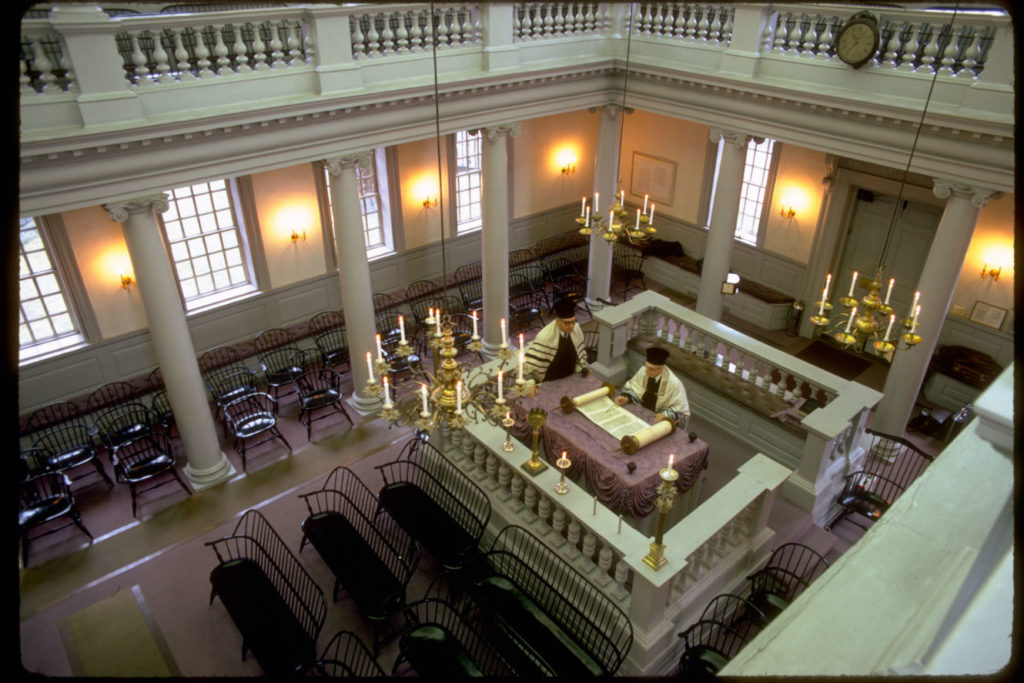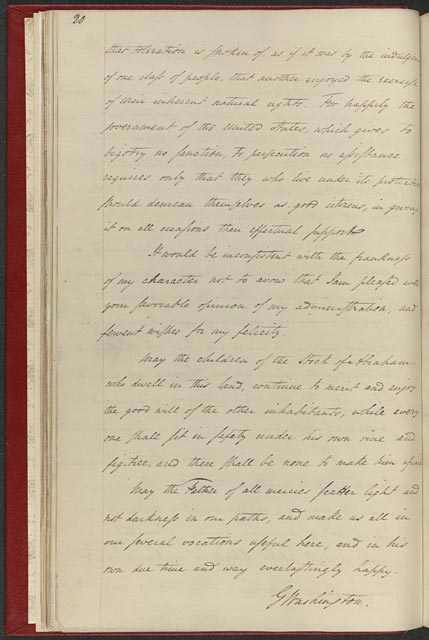Please Don’t Put Guards at My Synagogue

The citizens of the United States of America have a right to applaud themselves for having given to mankind examples of an enlarged and liberal policy — a policy worthy of imitation. All possess alike liberty of conscience and immunities of citizenship.
It is now no more that toleration is spoken of as if it were the indulgence of one class of people that another enjoyed the exercise of their inherent natural rights, for, happily, the Government of the United States, which gives to bigotry no sanction, to persecution no assistance, requires only that they who live under its protection should demean themselves as good citizens in giving it on all occasions their effectual support.
August 1790 Letter from President George Washington to the Hebrew Congregation of Newport, Rhode Island
Like many of the inspiring words of our nation’s founders, George Washington’s ideal of giving “to bigotry no sanction, to persecution no assistance” has often been honored more in the breach. America’s track record when it comes to the treatment of minorities, including Jews, is far from perfect. Institutionalized bigotry and exclusions were facts of life for the nation’s Jewish citizens for much of American history. On occasion, as in the case of Leo Frank in 1915, religious bigotry led to violence. The tragic deaths of 11 worshippers at the Tree of Life Synagogue in Pittsburgh constitute the worst mass murder of Jews in America’s history. In Europe, that number wouldn’t even make the top thousand. Religiously motivated violence, against people of all faiths, while never completely absent from the United States, has not led to pogroms and massacres in the way it has in so many other places in the world. The principle of religious freedom is indeed among the greatest gifts our founders bequeathed to Americans.

Washington’s letter to “The Hebrew Congregation in Newport, Rhode Island,” August 18, 1790. (Credit: Wikimedia Commons)
Fast forwarding to 20th century America, the relationship between America and its Jews has been nothing short of a love affair. Waves of Eastern European Jews, including my grandfather, left the ghettos of Eastern Europe and headed for what was known in Yiddish as the “Goldene Medina,” the country of gold, in the late 19th and early 20th centuries. In the decades before the founding of the state of Israel, this was their new promised land. These were the tired and poor huddled masses “yearning to breathe free” that Emma Lazarus, herself a descendant of Jewish immigrants, envisioned. When they arrived on our shores, many of their fellow Americans may have viewed them as that “wretched refuse” and didn’t want to live next door to them, let them join their country clubs, or let their sons or daughters marry them, but these immigrants worked hard, got educations, and barriers began to fall.
My own grandfather fled a place with no future in a shtetel in Lithuania when he was just a teenager with no English, no money, and little education. One of his four sons, my Uncle David, would graduate Harvard and Harvard Law and be a classmate of Supreme Court Justice Ruth Bader Ginsburg. Today, there are more Jews and Catholics (also no strangers to religious bigotry) on the Supreme Court than there are Protestants. In virtually every field of social, cultural, scientific, academic, political, and economic endeavor, American Jews have reached the heights never dreamed of by the hundreds of generations before them spread throughout the Diaspora. The preoccupation of virtually every Jewish community in the United States, and in fact every set of Jewish parents, is the astoundingly high rate of intermarriage, now around 50 percent. The biggest challenge to our community’s survival isn’t that the Gentiles hate us, it’s that too many of them love us.
It was in this America that I grew up — one where being Jewish placed absolutely no limitations on any part of my life. In thousands of years of Jewish history, with just a few brief exceptions, this is very rare. And it is largely because of this remarkable story of America and its Jews that I chose to serve my country in uniform. This was atypical for a nice Jewish boy from the suburbs of San Francisco, but I wanted to go to the Air Force Academy because I wanted to say thank you to the nation that had been so good to my family. My career topped out at lieutenant colonel, but the current and one former Air Force Chief of Staff share my heritage. In our military, there have been incidents from time to time when superiors overstep their bounds and seek to proselytize in the ranks, but where one goes, or doesn’t go, to church is not a barrier to advancement.
Because of my career, and because I love to travel, I have been privileged to live and work and see life in many other countries, principally in Latin America and Europe. And in all these places I have gone to synagogues. Invariably when I go to worship overseas I find features you don’t see in American synagogues — walls, gates, armed guards and metal detectors. Once, in order to attend services, while attending Spanish language training in Guatemala which coincided with the Jewish High Holy Days, I had to phone the rabbi ahead of time to get on a list, be sure that I brought my passport, and could answer the questions of the guards when I showed up at the gate of a 20-foot wall that surrounded the building.
As a teenager, my daughter was the president of a worldwide Jewish youth organization. At one of the international conventions held in the United States, some of the kids from Europe and Latin America asked her if it was safe for them to wear a yarmulke (a Jewish head covering), jewelry with Hebrew letters, or a t-shirt with the logo of the Israeli Defense Forces. She looked at them quizzically, and had difficulty understanding why they would ask such a question. She replied yes of course: “This is the United States of America.” Her friends explained that in their countries it might be too risky to do such things and they were grateful that at least while here, they could wear symbols of their ethnic and religious pride proudly. They hoped for a day when it would be true in their countries as well. In those moments when I encounter walls overseas or my daughter hears such stories, my heart swells with pride in my country and I have incredible gratitude to my grandfather, who got on a boat a century ago and came to the United States.
So as a former intelligence officer who has had to deal with any number of threats, when I hear that some, out of very worthy motivations, speak of putting armed guards at synagogues and adopting other more stringent security measures, I get it. It seems only prudent to consider these things. On the other hand I am deeply troubled by these notions. That people are no longer safe in a synagogue in Pittsburgh or a church in South Carolina or a Sikh temple in Wisconsin, or a mosque in Minnesota does not just threaten the people in these houses of worship but threatens that very core principle that is one of the things that makes America that truly exceptional nation. Putting up walls and arming guards is an admission of defeat. It says that there are too many in America who do not believe in religious freedom after all. I for one am not ready to concede that. Of course, we should be smart and prudent, not stupid or naïve, but I fear that building walls is the path of least resistance and lets us all of off the hook. I prefer that we double down on our principles and make that same radical bet that those men made back in Philadelphia two centuries ago: That it is possible to build a religiously pluralistic society where everyone can worship or not worship according to the dictates of his or her own conscience, free from fear or coercion.
Washington told the Jews of Newport that he wanted America to be a land where “every one shall sit in safety under his own vine and fig tree and there shall be none to make him afraid.”
I think the father of our country knew what he was talking about.
Rob Levinson is a retired lieutenant colonel in the U.S. Air Force with over 20 years of service as an intelligence officer. He is a graduate of the Air Force Academy and served in Latin America, the Middle East and South Korea as an intelligence officer, foreign area officer, commander and politico-military affairs officer. He currently works as a defense analyst.

